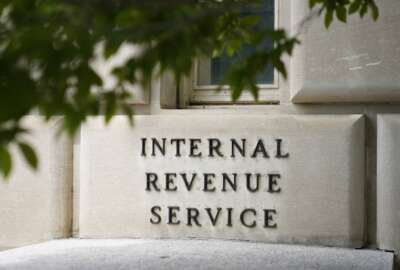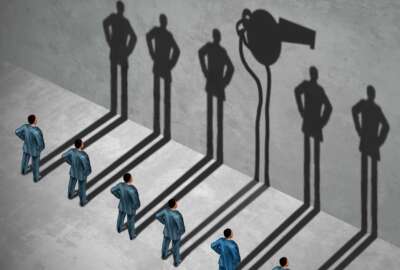Hubbard Radio Washington DC, LLC. All rights reserved. This website is not intended for users located within the European Economic Area.
What a presidential transition looks like from inside an agency
The upcoming presidential transition, once complete, will bring nearly 4,000 new political appointees into the federal workforce, but the new presidential admin...
Listen to Chris Lu on the Federal Drive
The upcoming presidential transition, once complete, will bring nearly 4,000 new political appointees into the federal workforce, but the new presidential administration will need the existing career civil service to get policy off the ground.
Presidential appointees often bring new vision and perspective to the departments they manage, but it’s the federal career workforce that ultimately carries out the business of government, Chris Lu, the deputy secretary of the Labor Department, told Federal News Radio.
Agencies’ career leadership, for example, helped implement the $800 billion stimulus package authorized by Congress mere weeks into President Barack Obama’s first term in 2009.
“In most federal agencies at that time, there was a confirmed secretary and there were a handful of political appointees surrounding that secretary, but there weren’t a lot of other people. There weren’t a lot of confirmed assistant secretaries, deputy secretaries. And so the mission of the job of getting the $800 billion out the door really fell upon career leaders who knew how these programs worked, who knew the best places to put the money, who knew how to implement the law and ensure that we were creating jobs and helping people back to work,” Lu said. “The success of the American Recovery and Reinvestment Act would not have been possible without the dedication of the career leadership, and I think it was a valuable lesson to all of us that if you simply rely on political appointees to advance your policy agenda, your policy priorities, you’re missing an important tool in career leaders.”
Few officials have seen a presidential transition unfold from Lu’s career path. As the executive director of the Obama-Biden Transition Project, he navigated the onboarding process with the incoming president. As the White House Cabinet Secretary, he served as the president’s liaison to the heads of top agencies. Now, as the second-in-command at the Labor Department, he serves on the team that will brief the next administration’s agency leadership.
“The challenge, I think for career leaders, coming in is obviously taking their cues from the new political leadership,” he said.
As a veteran of the presidential transition process, Lu said the career workforce — more than 2.79 million strong, according to the Office of Personnel Management — serves as the bedrock of the business of government when political appointees are settling into their roles. Just as well, when it comes to surviving the transition, most careerists shouldn’t have to prepare for a bumpy ride.
“For the overwhelming majority of people in the federal government, what their job is on Jan. 21, 2017 will not be any different than what it was January 20, 2017. Here at the Department of Labor, we’re still going to be training people for jobs, helping people find jobs, we’re still going to be protecting people in the workplace,” Lu said in an interview with Federal News Radio. “Whether you’re at the Veterans Affairs Department and you’re helping to provide health care, or whether you’re at the Department of Transportation ensuring that buses and trains and airplanes run on time, that’s the business of government, and that doesn’t change, regardless of who the president is.”
When it comes to carrying out an agency’s mission under new leadership, Lu said it takes a “balancing act” between the career and political workforces. The career civil service provides institutional history to inform new policy proposals, while the political hires have the better sense of the new president’s policy vision, and may offer new perspectives from outside government.
“I think that creative tension is a good thing. A change is good, it’s always good to have new perspectives and new approaches. It’s important for political leaders to come in with this desire to shake things up a little bit, to try things in a different way,” Lu said. “And it’s equally good for career leaders to say, ‘Hey, let us tell you how that’s worked in the past,’ or ‘That’s a great idea, but maybe you should think about it this way,’ or ‘Here’s some things you ought to consider, some challenges that might impede progress. I think that’s a good, healthy dynamic to have.”
Bringing a new administration on board
Agency leaders come and go, but the work and responsibilities of their department rarely let up. When it comes to drafting Labor’s transition documents, Lu said the career workforce’s institutional memory sets the groundwork for the next Labor secretary’s team.
“It’s not only providing what is going on now and what some ideas are of future proposals, future initiatives, but how we got to this point. It’s level-setting, and it’s important to understand that new agency leadership, it varies in terms of their familiarity with the issues, their familiarity with the departments. There’s no substitute for having worked in a department, as to understanding some of the opportunities and challenges there,” Lu said.
Likewise, the transition documents don’t follow a one-size-fits-all approach. The incoming Labor secretary, Lu said, receives the most comprehensive briefing, and has to hit the ground running on day one, but other tiers of management receive a more nuts-and-bolts primer on their departments.
“You obviously have to prepare for a confirmation hearing and some of the immediate challenges and decisions that will face him or her in those first 30, 60, 90 days. That’s really at a much higher level than, let’s say, an assistant secretary at the Department of Labor who handles OSHA [Occupational Safety and Health Administration], where that person really needs to understand in granular details the workings of OSHA, but probably doesn’t need to know about other broader departmental issues and challenges,” Lu said. “It’s a bifurcated approach.”
For his own role, Lu said his preparation for whatever new job he took on was to learn as much as possible about the opportunities and challenges.
“It is critically important to sit down with your predecessor, and I would argue not only your immediate predecessor, but all previous predecessors, as many as you can find along the way,” he said, before adding that he’s spoken with six of the last seven deputy labor secretaries.
Lu also said he shares a close friendship with his most immediate predecessor, Seth Harris, who also briefly served as the acting Labor secretary.
Democrat or Republican, Lu said his predecessors have offered unique insights into his position.
“In terms of the challenges of these jobs, there’s nothing particularly partisan about what some of those challenges are, and it’s helpful just to get the perspective of people who have done these jobs before,” Lu said. “It’s useful to have them on speed-dial because, as I always say, I guarantee whatever I face, they’ve faced in the past.”
‘Seamless’ workforce to meet challenges
In order for a new administration to gain traction in its first few months, Lu said a “seamless” relationship between politicals and civil servants is the best way to carry out the functions of government.
In the wake of political vacancies, some career employees have led certain sub-agencies, including Labor’s Office of Disability Employment Policy and the Office of the Chief Financial Officer. However, Lu said they’re not just keeping the seat warm.
“They’re not just caretakers, they’re not just keeping trains running on time. They’re really driving initiatives that further the secretary’s goals, and so they’re an integral part of our leadership team,” he said.
Best practices from the ‘most improved’ agency
Improving workforce morale often leads to greater agency efficiency. As the most improved agency, according to the 2015 Best Places to Work in the Federal Government data, the Labor Department has become a case study in getting the most out the existing government workforce.
“This is the case that I would make to any incoming leadership in any federal department: The truth is, we’re all going to hope for higher budgets, we’re all going to hope for an ability to hire more people, but given the fiscal realities that we live in, it is likely that we will not be able to add significant numbers of new employees,” Lu said. “And so your ability to do your agency’s mission is really dependent upon your employees giving more — your employees being more effective, being more efficient, being more engaged.”
Copyright © 2024 Federal News Network. All rights reserved. This website is not intended for users located within the European Economic Area.
Jory Heckman
Jory Heckman is a reporter at Federal News Network covering U.S. Postal Service, IRS, big data and technology issues.
Follow @jheckmanWFED





